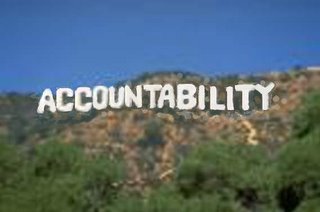Apologetics, tragedy and sleaze
| A convergence of conversation and tragedy has me blogging this morning (when I should be gradng papers...). The press comment I made on the GAO report on FEMA's post-Katrina action (see previous post) led to an extended conversation with a reporter (which is still ongoing -- we keep getting interrupted) who reacted to my stand by accusing me of being an apologist for incompetent bureaucrats. This is the third time I have run into this attitude on the part of reporters which either speaks to my lack of clarity or their bureaucracy-bashing "bias" that makes them treat me as if I am the Ann Coulter of the public administration community.... My point was simply that GAO's report reflects a knee-jerk, investigative reporting perspective that is neither in the tradition of GAO nor appropriate for a government audit. While the report is solid methodologically, it fails to provide information on the context and constraints under which FEMA was operating -- that is, GAO went for the headline rather than take the time to issue a credible analysis that is up to its past standards. Somehow that stand makes me an apologist for incompetent bureaucracies. I think I have been as clear as I can be, but it seems that the reporters have their own agenda and read a great deal more into my critique than is there.... The immediate reason for this blog post, however, is the relevance of that news media bias to the coverage of the tragic events that took place in Boston's Ted Williams tunnel Monday night. You can get the details of the accident in the news coverage, and it clearly looks like a critical flaw in the design, construction and maintenance of the tunnel ceiling. But already the media is seeking someONE to blame, a head to roll -- and the pols are feeding the frenzy-driven witchhunt for their own purposes. Governor Mitt Romney, for example, who is in a battle over control of the Massachusetts Turnpike Authority governing board (the tunnel is under MTA jurisdiction) is actually pointing fingers at his nemesis on that Board -- as if he personally went out and cut the bolt that led to the collapse of the ceiling tiles that led to the death. In the meantime, state Attorney General Reilly, who is in a primary battle for the Democratic nomination for governor, is treating the event as a crime, as if this was a premeditated murder (or at least negligent homicide). And the Boston media is loving it (this morning's Globe headline: Mass. Crisis of Confidence; the Herald is making it even sleazier....) I suspect I will be accused of being an apologist for incompetent bureaucracies or bolt manufacturers, but I want to point out that the causes of these accidents are more often than not much more complicated than we wish they were. It would make us all feel safer, I suspect, if we could just instantaneously find the specific individual or event or thing that led to this tragic death, and ironically we would feel better if we could zero in on some single individual to blame for committing this "criminal" act. But as much as we wish to revert to such medieval witchhunting, I hope wiser and cooler heads will prevail and a more careful and thorough investigation is conducted. The model I would point to is the investigation -- journalistic as well as forensic -- that followed the collapse of the walkway at the Kansas City Hyatt in 1981. 114 people died, and more than 200 injured. In what turned out to be a case of exemplary civic and responsible journalism, the Kansas City Star hired engineering consultants who conducted a thorough investigation of the collapse, and what they uncovered was a story of design changes, miscommunication, etc that did not warrant criminal charges, but led to charges of "gross negligence, misconduct, and unprofessional conduct" against the architectural engineers involved and actions against their firms -- and ultimately civil law suits and settlements. The paper won the Pulitzer for its coverage. One can only hope that after the feeding frenzy and headline grabbing subsides, the Globe and others turn to the model of Kansas City and its paper for guidance.... Tags: |

Comments on "Apologetics, tragedy and sleaze"
post a comment